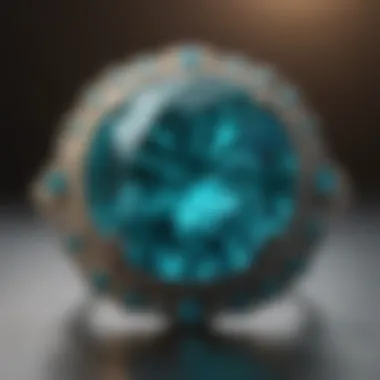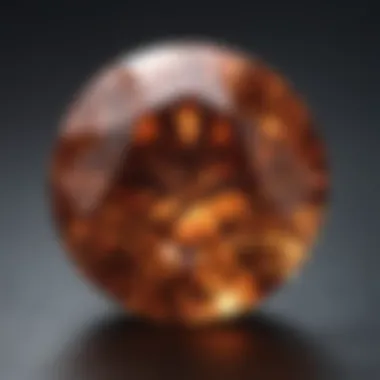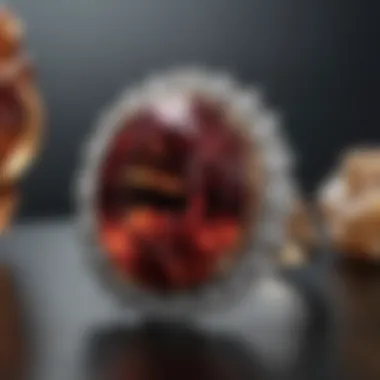Unveiling December's Birthstone: Turquoise, Tanzanite, and Zircon


Intro
December's birthstones hold a unique significance in both historical and cultural contexts. This month grants us the opportunity to celebrate and recognize turquoise, tanzanite, and zircon, each of which has distinct characteristics and stories. Understanding these gemstones goes beyond their aesthetic appeal. It involves a thorough exploration into their formation, properties, maintenance, and applications in jewelry design. Each section of this guide will provide rich detail to instill knowledge and appreciation for December's remarkable birthstones.
Overview of Gemstones and Minerals
History of Gemstone and Mineral Use
For centuries, humans have admired and utilized gemstones in various capacities. Historically, gemstones have played pivotal roles in society, varying from tools for navigation to symbols of power and wealth. Cultures such as the Egyptians, Greeks, and Romans revered certain gems, much like turquoise which appeared in ancient artifacts and jewelry. Across civilizations, beliefs surrounding gemstones often connected to their presumed mystical properties.
Significance in Culture and Society
Gemstones serve more than a decorative purpose in societies worldwide. They often convey sentiments, offering birthstones as gifts symbolizing bond and protection. December's stones, especially turquoise, are thought to bring good fortune and health. In some cultures, these gemstones are also connected to protecting the wearer from misfortune.
Gemstone Formation and Properties
Formation Process of Gemstones
The journey of a gemstone begins underground, through intricate geological processes. Each stone forms in unique environments. For instance, turquoise creates in arid regions and suggests timely interactions between copper, phosphorus, and water. Tanzanite, which is much sought after, forms under intense heat and pressure, mostly found in Tanzania. The formation logi ultimately impacts their rarity and value.
Properties that Define Gemstones
Gemstones can be classified based on their individual properties, including hardness, color, and luster. Hardness, measured on the Mohs scale, establishes durability. An example is zircon, which scores between 6.5 and 7.5, ensuring a balance between beauty and strength. Furthermore, color arises from a gemstone’s chemical composition—that hints the stunning, rich blues observable in tanzanite.
Classification based on Color, Hardness, and Luster
Gemstones can be classified in terms of color varieties, hardness scales, plus reflections:
- Vivid Colors: Variations as seen in turquoise, which range from teal to greenish-blue.
- Lustre Levels: Ranging from glossy to vitreous based on their cut, mostly important in evaluating tanzanite.
- Hardness Ratings: Noting the distinctions; for example, zircon shows diverse hardness levels reflective of its specific kind.
Types of Gemstones
Precious vs.
Semi-Precious Gemstones
There exists a general distinction between precious gems and semi-precious gems. Usually, the title of a “precious gemstone” applies to diamonds, emeralds, sapphires, and rubies. Yet, December's birthstones, such as tanzanite, define a subset within this classification due to their less common availability, proving their artistic value to jewelers.
Common Gemstone Varieties
Common systems categorize gemstones conveniently. This includes ideals like:
- Turquoise: Notable for its historical context, originating mostly from Iran and the Southwest U.S.
- Tanzanite: Recent discovery yet immediate prominence based on unique aesthetics and cultural references.
- Zircon: Often confused with cubic zirconia, its natural state serves as a metaphysical stone.
Exotic and Rare Gemstones
While staying aware of each December stone, various exotic types hold appeal for curious gemstone enthusiasts. These can include rare forms of zircon found in various locations worldwide vying for market visibility, while their tanzanite variants exist using the same creative mechanisms yet yield exceptional craftsmanship.
Identifying and Evaluating Gemstones
Factors Affecting Gemstone Value
Multiple factors consider the worth of a gemstone. Rarity typically plays a central role, along with quality variables:
- Clarity of the gemstone
- Cut quality
- Carat weight
- Authenticity and sourcing of the material
Techniques for Gemstone Identification
Identifying gemstones often requires careful scrutiny through various techniques. Regular methods include simple tools like loupes for checking clarity and color depth or advanced forms such as labs’ spectroscopy evaluating the samples for authenticity.


Assessing Gemstone Quality
To evaluate a gemstone correctly:
- Observe color variations for intensity and balance.
- Check cuts and polish for hints of light existence.
- Look for identifiable inclusions which denote stability.
Caring for Gemstones
Cleaning and Storing Gemstones Properly
Storing gemstones requires intentionality. Each sparks a suggestion to use proper pouches to isolate touching, thus averting scratching. Turquoise requires mild cleaning solutions due to sensitivity while tanzanite's stability needs treatment over any harsh chemicals.
Avoiding Common Mistakes in Gemstone Care
Practicing caution aids longevity. One common mistake is exposing stones to extreme temperature changes inappropriate. Using ultrasonic cleaners proves critical caution—avoiding certain stones over prolonged key exposure to these methods.
Preservation Tips for Specific Gem Types
Lastly, keeping each stone distinct might request various care regulations:
- Turquoise enrichment call for avoid direct sunlight.
- Tanzanite flourishes best in soft cloths away from scratches.
- Zircon, stronger technically, permits sharp variational abuses yet requires discerning wrapping.
Learning to care for these gems enhances your collectibles' life! Ensuring rich experiences rejuvenates personal beliefs when managed accurately.
In the sections ahead, a rich exploration of January's gemstones—aligned naturally within the artistic and graphic natures—further underlines our narrative journey celebrating these stones designed by nature.
Preface to December Birthstones
December’s collection of birthstones presents a rich tapestry of colors, meanings, and cultural significance. As the last month of the year, December offers three unique gemstones: turquoise, tanzanite, and zircon. Each of these stones not only boasts distinctive physical traits but also carries deep historical narratives and significant cultural symbolism. The inclusion and exploration of these birthstones in this article aimed at gementhusiasts will delve into finer aspects of their appeal, making it an essential read for those wanting to understand their significance in more depth.
Definition and Significance
The term birthstone refers to gemstones that are traditionally associated with a particular month, often believed to hold specific meanings, attributes or benefits. December's birthstones are no exception, each linked with various virtues and characteristics. Turquoise, celebrated for its distinctive blue-green hues, connects with peace, protection, and good fortune. Tanzanite, with its vibrant violet-blue shade, symbolizes transformation and intuition. Finally, zircon, ranging through a spectrum of colors including vibrant blue, holds connotations of wisdom and honor. The significance of these stones goes beyond superficial allure. For many collectors, they are treasures of history and legacy — a connection to the personal memories of ones born in December. Understanding these definitions is crucial for any gemstone enthusiast
Historical Context
The roots of December's gemstones stretch back into many cultures, revered since ancient times. Turquoise was utilized by Native American tribes and appreciated for its connection to the earth and prosperous harvests. It was often crafted into jewelry and talismans, symbolizing wealth and divine protection.
Tanzanite, discovered in the 1960s in Tanzania, has rapidly garnered international attention. Its commercial introduction has not diminished its allure; instead, it adds a modern perspective to the ancient traditions attached to gems.
Zircon, with a history predating many modern stones, was once a popular substitute for diamonds and became acclaimed for its brilliance and diversity. The enduring appeal of zircon can be traced through centuries, tinged with tales of treasures adorning important figures Across the ages, the lineage of these stones has interwoven with human stories, which in turn bring context and meaning that transcends their spective beauty. This historical exploration equips gemstone enthusiasts with a dimension of understanding, allowing them to appreciate their value even more deeply.
Main Birthstones for December
The importance of December's birthstones cannot be understated. Each stone brings unique qualities and significance, embodying various cultural, historical, and aesthetic elements. Understanding the main birthstones—turquoise, tanzanite, and zircon—allows enthusiasts to appreciate not just the beauty of these gems, but also their multifunctional applications in jewelry and personal adornment.
Turquoise
Physical Properties
Turquoise is known for its vibrant hues, ranging from turquoise to deep blue. This gemstone is composed of copper aluminum phosphate. The composition affects its overall beauty and integrity. Notably, its matrix varies widely and can include brown or black veining, providing character to each stone. This imperfect quality is appealing to many buyers looking for unique pieces.
Cultural Significance
The cultural significance of turquoise stretches back to ancient civilizations. It was valued by Native Americans and Egyptians alike. For many cultures, it serves as a symbol of protection and bravery. This long history emphasizes its importance, as wearing turquoise is believed to convey strength and goodwill to the wearer.
Modern Usage
In contemporary jewelry design, turquoise remains popular. Its unique color makes it a favirite for artisans. It pairs well with both gold and silver settings, making it versatile across various jewelry styles. However, some critiques mention that turquoise may be more susceptible to scratches compared to harder stones, a consideration for potential buyers.


Tanzanite
Discovery and Origin
Tanzanite was discovered in the 1960s in Tanzania. The unique origin has made it quite valuable, as it is found nowhere else in the world. The sudden appearance in the gem market captured attention quickly. Many collectors view it as a once-in-a-lifetime gemstone due to its rarity.
Physical Characteristics
These gems exhibit a unique trichroism, reflecting shades of blue, violet, and burgundy depending on the angle of light. That distinctive feature enhances its appeal, making well-cut tanzanite valuable. Jewellers who recognize this characteristic often emphasize its adaptability in various pieces.
Market Trends
Over the past few decades, there has been a notable increase in the demand for tanzanite. As more people become broke aware of its existence and beauty, its appeal continues to grow. However, because of its limited supply, pricing tends to be inconsistent, centralizing luxury on higher-quality stones.
Zircon
Common Varieties
Zircon is available in multiple colors, such as colorless, blue, and green. The diversity makes it an attractive option for collectors and designers. Interestingly, its color can be enhanced significantly through heat treatment, a characteristic desirable in contemporary market trends. Selections with unique color variation can fetch higher price points due to their rarity.
Chemical Composition
Zircon consists of zirconium silicate, classifying it among the silicate family. This grade influences its properties, such as brilliance. With a high refractive index and strong dispersion like diamond, zircon represents an economical alternative worthy of consideration in replacement conversations.
Value Assessment
Assessing zircon's value involves parameters like color, clarity, and treatment history. The combination of these factors can significantly influence its market value. While less known than other gemstones, high-quality zircon still holds financial worth valued by a niche market.
Comparative Analysis of December Birthstones
Understanding the comparative analysis of December birthstones is critical in appreciating their unique attributes. This section provides a detailed examination of how these gemstones stand in relation to one another. It covers both aesthetic and market elements that can influence choices for collectors, designers, and enthusiasts.
Comparison of Aesthetic Qualities
Aesthetic qualities play a vital role for individuals selecting a gemstone for personal use or for jewelry purposes. Turquoise, tanzanite, and zircon each exhibit distinct visual characteristics that attract different preferences.
- Turquoise: Often recognized for its vibrant blue hue, turquoise can feature inclusions that contribute to its distinctive look. Its matrix, comprising black or brown veins, lends uniqueness to each piece, making it increasingly sought after.
- Tanzanite: Known for its captivating rich blue and violet tones, tanzanite exhibits pleochroism, meaning its color changes when viewed from different angles. This quality makes tanzanite particularly enchanting in various light conditions.
- Zircon: Zircon shines brightly with its brilliance and can mimic diamonds when cut correctly. The assortment of colors available enhances its appeal, although the natural blue variety is most aligned with December's celebratory theme.
Ultimately, the choice of gemstone relates to individual taste. The variances in colors, textures, and overall appeal determine their desirability thus impacting how they are perceived within the industry and loved by consumers.
Market Popularity
Market popularity reflects how often each ofs the December birthstones is sought-out by buyers and collectors. These trends are shaped by various factors including societal influences, awareness, and quality.
- Turquoise: This gemstone remains notably popular, partly thanks to historical contexts and cultural relevance. Often favored in southwestern jewelry styles, its charm continues to captivate various demographics.
- Tanzanite: Since its recent discovery in the twentieth century, tanzanite rapidly gained accolades. Its precious nature and limited geographical sourcing have accentuated its allure, making it a favorite among high-end buyers.
- Zircon: Though less mainstream than its peers, zircon is regaining traction due to growing interest in affordable yet luxurious alternatives to diamonds. The myriad of stunning colors adds to its appeal in rings and pendants.
Considering all this, a personalized analysis of market patterns can benefit purchasers in understanding what gemstones like turquoise, tanzanite, or zircon might fit their style as well as investment strategies.
Gemstone Care and Maintenance
Taking care of gemstones is essential to maintaining their beauty and durability. Proper care ensures that valuable pieces, like those associated with December, remain vibrant for years. Each stone exhibits unique properties, and understanding how to care for them prevents scratches, chips, and discoloration. This section will focus on best practices for cleaning and storing your December birthstones. Caring for these gems not only preserves their physical appeal but also enhances their value over time.
Cleaning Techniques
To maintain the luster of turquoise, tanzanite, and zircon, appropriate cleaning methods are vital. Here are methods specific to each stone:
- Turquoise: This stone requires gentle care. Use a soft, loving cloth dampened with water. Avoid chemicals that may ruin its surface.
- Tanzanite: Clean tanzanite with lukewarm, soapy water and a soft brush. Rinse well and dry with a soft cloth. Avoid extreme temperature changes, as this may risk causing fractures.
- Zircon: Given its hardness, zircon can handle a little more. It should still be cleaned with mild soapy water and a soft brush to prevent scratches.
Regular cleaning prevents residue buildup from lotions or perfumes, which may dull the stone. Ensure to follow careful techniques.


Storage Recommendations
Correct storage mitigates the risk of damage when the gemstones are not in use. Consider how to best store your December birthstones:
- Separate Compartments: Use lined boxes or pouches for each stone. Providing individual space prevents them from scratching each other.
- Temperature Control: Store gems in a stable environment, away from extreme heat or humidity, which could adversely affect durability.
- Avoid Sun Exposure: Prolonged sunlight may fade colors, especially for turquoise. Keep stones in a shaded, cool area.
Additionally, labels or notes indicating the details of each gemstone can aid in maintaining your collection. Taking simple preventive steps goes a long way in preserving your precious gems.
Proper gemstone care is not merely maintenance; it's an investment in future elegance and value.
Cultural Perspectives on December Birthstones
Understanding the cultural perspectives on December birthstones enhances the appreciation for their significance beyond aesthetics. A thorough exploration of traditional beliefs and modern interpretations reveals how people connect emotionally and spiritually with these gems. These facets of cultural relevance bring depth to the December birthstones, allowing them to serve as more than mere ornaments or investments. Recognizing these elements fosters respect for the heritage and meanings attached to turquoise, tanzanite, and zircon.
Traditional Beliefs
Historically, gemstones have held various meanings across cultures. In many ancient civilizations, the belief in the protective and healing properties of gemstones was prevalent. Turquoise, for instance, has been valued by Native American tribes for its protective qualities. It was believed to bring good luck and clear communication. Often, a gift of turquoise was not just about its beauty but conveyed deeper sentiments of love and protection.
In addition, tanzanite, which is a more recent addition to the list of birthstones, has also garnered mythical importance in modern belief systems. Some cultures regard this stone as a bridge between the physical and spiritual realms, thereby promoting peaceful interactions and harmony.
"Turquoise is considered a stone of friendship; it brings peace to the wearer."
Zircon, appearing cautions as it can be confused with synthetic materials, signifies integrity and wisdom to numerous cultures. The blue variants are especially considered fortunate in various Eastern philosophies.
Modern Interpretations
Contemporary views regard gemstones as not only beautiful but also as symbols of personal expression. Today, many people choose to wear December birthstones according to their preferences, eschewing the traditional belief associated with their corresponding birth month. Instead, individuals select stones that resonate with their personalities or philosophies. For example, tanzanite's deep blue color may be appealing to someone with a contemplative nature and an appreciation for tranquility.
In the realm of social media and digital clubbing, communities often discuss the meanings and experiences surrounding these stones. Reddit, for instance, features threads that delve into personal stories associated with turquoise or what wearing zircon during key events means for individuals.
Moreover, there seems to be a growing trend in personalized jewelry. Consumers often opt for custom pieces that incorporate symbols associated with their beliefs and values, transcending traditional inventories.
Overall, the cultural perspectives on December's birthstones illustrate how symbolism associated with turquoise, tanzanite, and zircon has evolved, emphasizing personal connections more than ever before.
Jewelry Design with December Birthstones
Jewelry design featuring December birthstones encompasses various aspects that attract gemstone enthusiasts and collectors. The unique attributes of each stone, including turquoise, tanzanite, and zircon, influence their applications and presentation in jewelry. Understanding the interplay between these factors helps both jewelry designers and buyers appreciate their value fully.
Design Trends
Contemporary jewelry trends often feature minimalist styles, where the natural beauty of gemstones can shine on its own. Turquoise designs have shifted from heavy, intricate pieces to simpler, elegant adornments. Fine gold or silver bands highlight the richness of tanzanite, showcasing its deep blue hues.
Unique settings, like bezels and prong mounts, emphasize geometric shapes in jewelry. Such trends offer a modern appeal while maintaining a connection to traditional styles. As a designer, it is vital to stay updated with evolving demands, ensuring that the creations are both contemporary and rooted in cultural recognition. This approach opens avenues for personal expression and custom jewelry that resonates with individual tastes.
Gemstone Pairings
Pairing December birthstones with complementary stones can enhance overall aesthetics. A few noteworthy combinations include:
- Turquoise and Coral: The vibrant hues create a harmonious contrast that draws attention.
- Tanzanite and Diamonds: The brilliance of diamonds paired with the richness of tanzanite exhibits luxury and refinement.
- Zircon and Amethyst: The warm tones of amethyst perfectly balance the cooler shades of zircon.
When design gemstones together, the color harmony matters, but so does the stone's physical qualities. Certain stones may not withstand scratching or wear as well as others. Thus, matching hardness ratings is essential to ensure longevity.
Designing jewelry takes patience, insight, and a keen understanding of the materials involved. These elements are not merely byproducts; they define the essence of each piece. For those interested in gemstone jewelry, careful contemplation of these aspects leads to more meaningful acquisitions.
Ending
The significance of recapping December's birthstones lies in consolidating the vast information gathered throughout the article. The variety presented – turquoise, tanzanite, and zircon – embodies a rich heritage stretching back through history. By summarizing the unique features of these gemstones, readers are better equipped to understand their importance within both cultural and commercial contexts.
Each gemstone offers distinct physical and aesthetic properties.
- Turquoise: Revered for its intense color and cultural ties, historically used in jewelry and ornamentation.
- Tanzanite: Known for its captivating deep blue hue, famed for its relatively recent discovery and growing market.
- Zircon: Offers visual diversity and is increasingly recognized for its brilliance and historical significance.
In this recap, readers are invited to reflect on the features and values of each stone, encouraging an informed choice for personal enjoyment or investment.
Recap of December Birthstones
December's birthstones have a unique allure, closely tied to various cultures and personal symbolism. Turquoise provides a calming presence, tanzanite introduces a magical charm with its complex shades, and zircon holds an age-old reputation for beauty and versatility. Mining areas similar to







